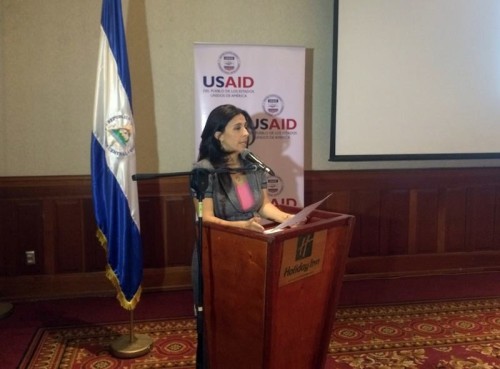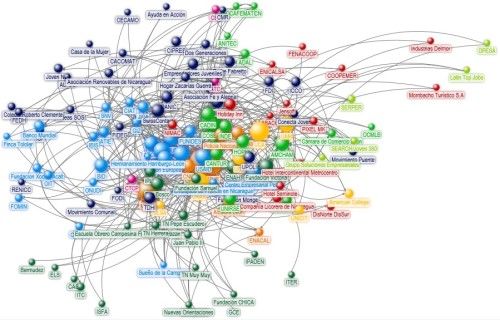October was a big month for learning and sharing results of LINC’s first-ever application of social network analysis to workforce development systems in Nicaragua. We began the month with a results presentation at the Youth Economic Opportunities Summit on October 7, an annual event in Washington DC attracting 450 participants from 50 countries. We followed this up last week on October 15 in Managua, hosting our own event in collaboration with USAID Nicaragua attended by approximately 40 organizations, most of which participated in the analysis. Scroll down to view presentations and the full research report in both English and Spanish.

USAID/Nicaragua’s Angela Cardenas delivers the introductory remarks on the importance of this study for future workforce development programming.
The October 7 Washington event highlighted what we can learn from application of social network analysis to workforce development systems, and the extent to which the approach is replicable to workforce development systems in other parts of the world. The presentation was led-off by Tim Sparkman of Denver-based Market Share Associates, who explained the basic tenets of network analysis and its fit among systems and complexity-aware analytical approaches. LINC Managing Director Patrick Sommerville then provided highlights of the Nicaragua research including some of its most salient findings and recommendations for design and strengthening of workforce development programs in Nicaragua. He ended the presentation with lessons learned for future application of social network analysis, which included the following ideas and advice:
- Carefully map network analysis to a theory of change or development hypothesis at the outset of the research.
- Establish a clear network boundary (e.g. common goal, geography), and consider both employers and job-seekers carefully, as they are a potentially limitless population.
- Expect little regional variation in metrics between multiple geographic networks where there is overlap among actors.
- Consider the willingness of network actors to participate in the survey, especially in centralized environments.
- Develop strategies to assess potential for network growth in the absence of a baseline. (e.g. desired linkages, comparative sub-networks).
Click these links to view English versions of: Results Presentation (PDF) and Final Report (PDF)

Network Map for Workforce Development in Nicaragua (Managua, Matagalpa and Leon)
The October 15 event in Managua attracted stakeholders interested in the practical results of the research, and specifically their own organizations’ place within the workforce development network. After a brief introduction by USAID/Nicaragua Director for the Office of General Development Angela Cardenas, LINC Managing Director Rich Fromer presented results of the analysis with specific attention on practical strategies to strengthen workforce development in Nicaragua. The presentation focused on findings and potential strategies for the whole network, the interconnectivity of actors around specific functional areas necessary to match supply and demand in the labor market, and for specific sub-networks with high-potential for impact. Several of the key findings include:
- The network overall is diffuse but resilient with no individual actor capable of disruption – development strategies should seek to maintain this resilient structure.
- Business Associations are influential and well-connected throughout the network – they are an ideal group to target as network hubs and able to bridge the various labor market functions to increase collaboration.
- NGOs are entrepreneurial, with diverse connections but little influence in the network – they represent an efficient channel to disseminate information and an opportunity to improve the balance of power in the network.
- Donors are highly influential in the network – this group should be engaged for their convening power to facilitate network growth and improve collaboration.
- Employment Agencies are not currently well-connected or engaged in the system – this is group whose involvement in workforce development could serve an important function to connect labor supply and demand.
- Vocational Institutions are better connected to donors than to employers, and not well-connected within their own group – strategies should focus on increasing collaboration and strengthening their connection to the private sector.
- Government is a dominant actor in the network – strategies should seek to involve government and to build connections among other actors to balance the network more evenly.
- Economic sector based sub-networks are stronger than the overall network – focus interventions to act around specific target sectors to increase effectiveness and grow the whole network.
Clear here to view the Spanish Results Presentation and Final Report.
